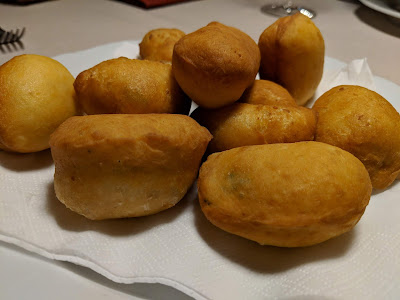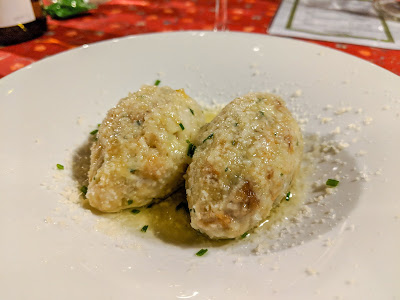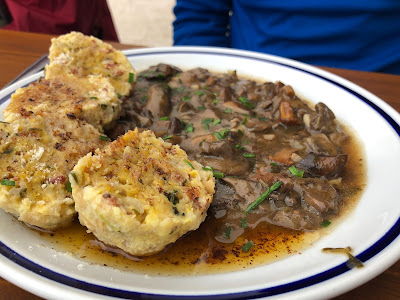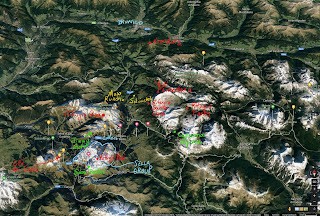Overview
In this post, we present a list of sets of words (pairs, triplets, etc.) that can cause confusion to new learners of the Italian language; The words in each set look alike but may or may not be spelled the same. Further, the words in each set are usually pronounced differently and have different meanings. You might be thinking that we are talking about homonyms (omonimi in Italian), and some are, but not all. In fact, the most "tricky" word sets can with words that are not homonyms but look and sound similar to an Italian language learner’s ear such that we could call them virtual homonyms.Technically, some of the word pairs below are referred to as a minimal pair, that is a words that differ only in one phonological element (sound, pitch, duration) but have distinct meanings.
Why are these similar words so hard for an English mother tongue speaker? We are not sure, but can say that from our experience learning the Italian language that we just don’t “hear” the difference easily. In a normal conversation, if someone says agnello (lamb), we might think anello (ring), and need to understand the context to correctly select the correct word. The two words look different, but in a noisy room or with a fast speaker, the two words anello/agnello can be hard to distinguish. (Try it.) I suppose we do the same in English with words that are true homonyms or words that are close in pronunciation, that is, we wait for the context to become clear before we know which word is correct.
Many of the word sets presented below involve one of the following characteristics:
- A subtle spelling difference between two different nouns that are not homonyms.
- One noun with a single consonant and another with the same consonant doubled. Double consonants or consonante doppia are the bane of our existence as they require a pronunciation that – given our English-speaking habits of mushing consonants together – means that listeners don’t hear our single or double consonants distinctly. Here are some common traps: anus (ano) and year (anno), house (casa) and cash register (cassa), and lighthouse (faro) and farro (farro).
- A change of one vowel between two similar-looking nouns. Examples include cimento (a feat or endeavor) and cemento (cement) and batterio (bacterium) and batteria (drums or battery).
- Similarity between a noun and a verb form. In some cases, the words are true homonyms. The post Conjugating Italian Verbs and Knowing Where to Put the Tonic Stress talks about nouns associated with (i.e., derived from or vice versa) from verbs.
- A noun that is similar or spelled the same as a conjugated verb form, sometimes with the same spelling. An example is the noun review (la rassegna) and the difference with conjugated forms of the verb to resign oneself (rassegnare: io rassegno, tu rassegni, lui rassegna).
- A noun that is similar or spelled the same as the past participle of a verb. For example, the noun choice (scelta) and the participle of the verb to choose (scegliere: scelto/a).
How did we come up with this list? Simple. Each and every one of the words below is one we've encountered in conversation or reading and reached for the dictionary to look it up (at least once and sometimes more). From our tendency to keep lists, this blog post was born.
(top)
The List
In the list below, the following abbreviations are used:
- “pp.” past participle
- “V” indicates a verb.
- “A” indicates an adjective.
- When a word is not marked with “V” or “A”, it’s a noun.
l ‘ago (attrezzo da cucito) / l'aglio (pianta aromatica) / l'agio (agiatezza, comfort)
l'agenzia (attività che offre servizi) / l'azienda (ditta, impresa)
l'agnello (piccolo della pecora) / l'anello (cerchietto di metallo)
l'allenamento (esercizio, addestramento) / l'allestimento (preparazione)
l'angolo (geometria: pezzo di spazio) / l'angelo (entità fatta di spirito)
l'ano (orifizio rettale) / l'anno (unità di misura del tempo)
l'allenamento (esercizio, addestramento) / l'allestimento (preparazione)
l'angolo (geometria: pezzo di spazio) / l'angelo (entità fatta di spirito)
l'ano (orifizio rettale) / l'anno (unità di misura del tempo)
l'aria (gas, clima, ambiente) / l'area (superficie)
l'ascolto (atto di sentire) / ascolta (V: ascoltare; presente: io ascolto, lui ascolta)
l'avocado (albero, frutto esotico) / l'avvocato (defensore, legale)
la bambola (pupazzo per bambine; ragazza avvenente) / la bombola (contenitore cilindrico per gas)
il banco (panca, sedile) / la banca (istituto di credito)
il baro (che bara al gioco) / la bara (cassa da morte) / la barra (trave, sbarra; simbolo "/")
l'ascolto (atto di sentire) / ascolta (V: ascoltare; presente: io ascolto, lui ascolta)
l'avocado (albero, frutto esotico) / l'avvocato (defensore, legale)
la bambola (pupazzo per bambine; ragazza avvenente) / la bombola (contenitore cilindrico per gas)
il banco (panca, sedile) / la banca (istituto di credito)
il baro (che bara al gioco) / la bara (cassa da morte) / la barra (trave, sbarra; simbolo "/")
il battèrio (microrganismo) / la batterìa (accumulatore di energia elettrica o strumento musicale)
il bruto (guidata dall'istinto) / il brutto (persona brutta)
la caccola (secrezione nasale) / calcola (V: calcolare; presente: lui calcola) / il calcolo (operazioni matematiche)
il bruto (guidata dall'istinto) / il brutto (persona brutta)
la caccola (secrezione nasale) / calcola (V: calcolare; presente: lui calcola) / il calcolo (operazioni matematiche)
il camìno (struttura per accendere un fuoco) / il cammìno (atto di camminare) / il càmion (automezzo da trasporto)
il camionista (chi guida camion) / il comunista (aderente al comunismo)
il campanile (torre campanaria) / la campana (strumento musicale in bronzo) / la campanella (piccola campanella) / il campanello (dispositivo sonoro) / il capannello (piccolo gruppo di persone)
i cannellini (i fagioli) / i cannelloni (grossi cannelli di pasta ripieni)
il camionista (chi guida camion) / il comunista (aderente al comunismo)
il campanile (torre campanaria) / la campana (strumento musicale in bronzo) / la campanella (piccola campanella) / il campanello (dispositivo sonoro) / il capannello (piccolo gruppo di persone)
i cannellini (i fagioli) / i cannelloni (grossi cannelli di pasta ripieni)
il cavalletto (sostegno) / la cavalletta (insetto, locusta)
la compagna (amica) / la compagnia (gruppo comitiva)
il cancello (portone) / la cancellata (recinzione) / cancellato (V: cancellare pp.)
il cappello (copricapo) / la cappella (piccola chiesa) / i capelli (i peli che coprono il capo)
il carro (mezzo di trasporto) / il caro (persona amata, amico)
la casa (abitazione) / la cassa (macchina per l'incasso)
il cassetto (mobili, scompartimento scorrevole) / la cassetta (contenitore quadrato)
il castagno (albero) / la castagna (frutto di castagno) / castano (A: del colore della castagna)
la compagna (amica) / la compagnia (gruppo comitiva)
il cancello (portone) / la cancellata (recinzione) / cancellato (V: cancellare pp.)
il cappello (copricapo) / la cappella (piccola chiesa) / i capelli (i peli che coprono il capo)
il carro (mezzo di trasporto) / il caro (persona amata, amico)
la casa (abitazione) / la cassa (macchina per l'incasso)
il cassetto (mobili, scompartimento scorrevole) / la cassetta (contenitore quadrato)
il castagno (albero) / la castagna (frutto di castagno) / castano (A: del colore della castagna)
il cavolo (pianta erbacea) / il cavallo (mammifero quadrupede) / il cavillo (argomento pretestuoso)
il cieco (personal non vedente) / il ceco (persona della Repubblica Ceca) / il cece (legume, alimento)
il cimento (prova rischiosa) / il cemento (impasto per costruire)
la ciotola (tazza larga) / il ciottolo (sasso levigato dall'acqua)
la colazione (pasto del mattino) / la collazione (confronto di copie diverse)
la colla (sostanza che attacca) / il collo (unione fra teste e torace) / la cola (tipo di pianta) / il colle
(piccola elevazione di terreno)
la colpa (atto contrario a leggi) / il colpo (urto; suono sonordo; evento di successo)
la coltura (coltivazione) / la cultura (insieme di cognizioni)
la copia (trascrizione fedele) / la coppia (insieme di due unità)
il coretto (coro musicale) / corretto (A: giusto, V: correggere pp.)
la corsa (atto o risultato del correre; tratta percorsa da un veicolo pubblico) / il corso (lo scorrere di qualcosa)
la coscienza (consapevolezza di sé stessi) / la conoscenza (atto o effetto di conoscere)
la culla (lettino; luogo di origine) / il culo (sedere)
il disegno (rappresentazione grafica) / disegno (V: disegnare; presente: io disegno, lui disegna)
il dirigibile (aerostato, può che essere diretto) / digeribile (che si digerisce facilmente)
i diti (considerati distintamente) / le dita (considerate collettivamente) / il dito (singola) / la ditta (azienda, impresa)
l'estere (composto chimico) / l'estero (paesi stranieri)
la faccia (volto) / faccio (V: fare; presente: io faccio)
il falò (fuoco accesso di proposito) / il fallo (errore, sbaglio)
il faro (luce per la navigazione) / il farro (varietà di frumento)
la folla (persone: assembramento) / la follia (malattia mentale) / il folle (pazzo, squilibrato)
la fame (acuto bisogno di cibo) / la fama (gloria, rinomanza, celebrità)
il faraone (titolo dell'antico Egitto) / la faraona (uccello)
le feci (escrementi) / fece (V: fare; passato remote: lui fece)
le Figi (arcipelago del Pacifico) / i fighi (cose forti)
il fioco (annodatura di un nastro) / il fuoco (effetto della combustione)
la forma (aspetto esteriore) / le forme (convenzioni) / formo (V: formare; presente: io formo)
la formìca (insetto) / la fòrmica (plastica laminata)
il freddo (gelo) / la fretta (premura, urgenza)
il frigo (frigorifero) / friggo (V: friggere; presente: io friggo)
il ghiacciaio (massa di ghiaccio) / la ghiacciaia (locale per il ghiaccio)
il giorno (ventiquattro ore) / la giornata (periodo da mattina a sera)
i giovani (non vecchi) / Giovanni (nome maschile) / giovane (A: non vecchio)
la gaurigione (il guarire qn) / la guarnigione (truppa militare, presidio)
il cieco (personal non vedente) / il ceco (persona della Repubblica Ceca) / il cece (legume, alimento)
il cimento (prova rischiosa) / il cemento (impasto per costruire)
la ciotola (tazza larga) / il ciottolo (sasso levigato dall'acqua)
la colazione (pasto del mattino) / la collazione (confronto di copie diverse)
la colla (sostanza che attacca) / il collo (unione fra teste e torace) / la cola (tipo di pianta) / il colle
(piccola elevazione di terreno)
la colpa (atto contrario a leggi) / il colpo (urto; suono sonordo; evento di successo)
la coltura (coltivazione) / la cultura (insieme di cognizioni)
la copia (trascrizione fedele) / la coppia (insieme di due unità)
il coretto (coro musicale) / corretto (A: giusto, V: correggere pp.)
la corsa (atto o risultato del correre; tratta percorsa da un veicolo pubblico) / il corso (lo scorrere di qualcosa)
la coscienza (consapevolezza di sé stessi) / la conoscenza (atto o effetto di conoscere)
la culla (lettino; luogo di origine) / il culo (sedere)
il disegno (rappresentazione grafica) / disegno (V: disegnare; presente: io disegno, lui disegna)
il dirigibile (aerostato, può che essere diretto) / digeribile (che si digerisce facilmente)
i diti (considerati distintamente) / le dita (considerate collettivamente) / il dito (singola) / la ditta (azienda, impresa)
l'estere (composto chimico) / l'estero (paesi stranieri)
la faccia (volto) / faccio (V: fare; presente: io faccio)
il falò (fuoco accesso di proposito) / il fallo (errore, sbaglio)
il faro (luce per la navigazione) / il farro (varietà di frumento)
la folla (persone: assembramento) / la follia (malattia mentale) / il folle (pazzo, squilibrato)
la fame (acuto bisogno di cibo) / la fama (gloria, rinomanza, celebrità)
il faraone (titolo dell'antico Egitto) / la faraona (uccello)
le feci (escrementi) / fece (V: fare; passato remote: lui fece)
le Figi (arcipelago del Pacifico) / i fighi (cose forti)
il fioco (annodatura di un nastro) / il fuoco (effetto della combustione)
la forma (aspetto esteriore) / le forme (convenzioni) / formo (V: formare; presente: io formo)
la formìca (insetto) / la fòrmica (plastica laminata)
il freddo (gelo) / la fretta (premura, urgenza)
il frigo (frigorifero) / friggo (V: friggere; presente: io friggo)
il ghiacciaio (massa di ghiaccio) / la ghiacciaia (locale per il ghiaccio)
il giorno (ventiquattro ore) / la giornata (periodo da mattina a sera)
i giovani (non vecchi) / Giovanni (nome maschile) / giovane (A: non vecchio)
la gaurigione (il guarire qn) / la guarnigione (truppa militare, presidio)
il legno (materia dei tronchi e rami) / la legna (pezzi di legno da ardere)
il letto (mobile per dormire) / letto (V: leggere; presente: io letto)
la lettura (atto di leggere) / la lettera (simbolo dell'alfabeto; testo)
il lilla (di colore tra il rosa e il viola) / il lillà (pianta, arbusto delle Oleacee)
il logo (marchio, simbolo) / il luogo (parte di spazio)
il lutto (dolore per la morte) / lotto (gioco di fortuna)
la marcia (manifestazione) / il marcio (ciò che è corrotto)
il mento (parte del viso) / la mente (intelletto) / la menta (pianta) / menti (V: mentire: presente: tu menti)
la mete (traguardo, destinazione, obbiettivo) / la metà (mezza parte di un intero)
il messaggio (notizia) / il massaggio (manipolazione muscolare)
la mola (antichi mulini) / la mole (quantità ingente)
il molle (che è morbido) / la molla (spirale elastica)
la nomina (conferire un incarico) / nomina (V: nominare; presente: lui o lei nomina)
il nono (nona parte, uno su nove) / il nonno (padre di genitore)
il paio (coppia di oggetti) / paio (V: parere; presente: io paio)
la pala (attrezzo per scavare) / il palo (asta) / la palla (corpo sferico)
il pane (tipo di alimento) / la panna (crema del latte)
il panello (focaccina) / il pannello (elemento piano)
la pappa (minestrina semiliquida) / il papà (padre) / il papa (pontefice cattolico)
il parmigiano (formaggio) / la parmigiana (pietanza a base di melanzane) / i parmigiani (abitanti di Parma)
il passeggio (camminata per svago) / il passaggio (testo, tragitto, via) / il paesaggio (veduta) / il passeggero (chi viaggio su un mezzo di trasporto) / il passeggino (seggiolino su ruote per bambini)
la passata (trattamento superficiale, salsa) / il passato (il tempo trascorso) / passato (A: avvenuto) / passato (V: passare pp.)
il pene (organo genitale maschile) / la pena (sofferenza) / la penna (uccelli, parte del piumaggio)
la pesca (cattura dei pesci) / la pesca (frutta del pesco)
il peto (scoreggia, aria intestinale) / il petto (torace umano o animale)
il piccione (colombo) / il piccone (attrezzo di ferro)
il pieno (apice, apogeo) / il piano (livello, parte di un edificio)
il pinocchio (seme di pino) / la pannocchia (spiga del granturco)
il principio (inizio; causa; valore) / il principe (figlio del re)
il poro (orifizio della cute) / il porro (ortaggio con bulbo; plurale: i porri) / porre (V: mettere, infinito)
il porto (luogo di attracco per navi) / la porta (soglia, accesso) / porto (V: porgere pp.)
la pulizìa (aspetto di ciò che è pulito) / la polizìa (tutelare l'ordine pubblico) / la pòlizza (documento assicurativo)
la rassegna (ispezione, rivista, mostra) / rassegno (V: rassegnare; presente: io rassegno)
la razza (gruppo etnico; stirpe) / la razzia (saccheggio armato) / il razzo (tubo con sostanze piriche; missile) /
il recapito (indirizzo di consegna) / recapita (V: recapitare; presente: lui recapita)
il regalo (dono, presente) / la regola (norma di comportamento) / il regolo (righello)
il rene (organo) / la rena (sabbia)
il reparto (sezione, dipartimento) / il riparo (protezione, rifugio) / riparto (V: ripartire; io riparo)
la ruga (solco della pelle) / la riga (linea dritta)
il riso (l'atto di ridere) / la rissa (zuffa, scontro)
il sale (cloruro di sodio alimentare) / lui sale (V: salire; presente: lui sale)
la scopa (oggetto per pulire) / lo scopo (fine, obiettivo) / scopo (V: scopare; presente: io scopo, lui scopa)
la scelta (atto o effetto dello scegliere) / scelto (A: di ottima qualità, es: gruppo scelto, squadra scelta) / scelto (V: scegliere pp.)
lo schermo (riparo, protezione) / la scherma (sport da combattimento)
la scommessa (puntata in giochi d’azzardo) / scommesso (V: scommettere pp.)
la scoperta (qualcosa di nuovo) / scoperto (A: senza difese, riparo) / scoperto (V: scoprire pp.)
la sera (ultima parte del giorno) / la serra (costruzione per la coltivazione)
la seta (fibra tessile) / la sete (bisogno di bere)
il seno (incavo tra le mammelle) / il senno (avvedutezza) / sennò (se no, altrimenti)
il sonno (stato del dormire) / sono (verbo essere, io sono)
lo spasso (divertimento, piacere) / se la spassa (V: spassarsela – divertirsi; presente: lui se la spassa)
lo spazio (area, posto) / lo spiazzio (spazio aperto) / spazia (V: spaziare = estendersi; presente: io spazio, lui spazia)
lo spoglio (voto: scrutinio) / le spoglie (salma) / spoglio (V:spogliare - svestire; presente: io spoglio)
lo sposato (coniugato) / spossato (A: privo di forza, esausto) / spossato (V: spossare pp.)
lo stilo (bastoncino per scrivere) / lo stile (caratteristiche formale)
lo stretto (tratto di mare tra due terre) / la stretta (atto di stringere) / stretto (V: stringere pp.)
la tasso (tributo; impegno) / il tasso (piccolo mammifero; interesse bancario) / il tassì (taxi)
il tato (che si prende cura di un bambino) / il tatto (senso della pelle) / il tattoo (tatuaggio)
il tavolo (tipo di mobile) / la tavola (asse di legno; libro: illustrazione; tipo di mobile)
il tendone (tenda da circo) / il tendine (tra muscoli e ossa)
il testo (contenuto di uno scritto) / la testa (parte del corpo) / tosta (A: sostanza: duro, sodo; persona: risoluto, duro)
il timore (preoccupazione) / il timone (nave: organo direzionale)
la tuta (indumento da lavoro), tutta (indica totalità)
l'uovo (gamete femminile, plurale: le uova) / l'uva (frutto delle vite, plurale: le uve)
la vergola (filo di seta o d'oro intessuto in drappi) / la virgola (punteggiatura: segno)
il vero (corrispondente a verità) / il verro (porco non castrato) / verrò (V: venire; future semplice: io verrò)
la vite (piante rampicante o elemento filettato) / la vita (individuo: esistenza)
il vitto (cibo) / Vito (nome maschile)
il volto (viso) / la volta (indica frequenza di un evento)
(top)



























































